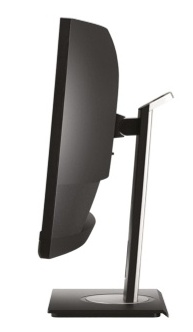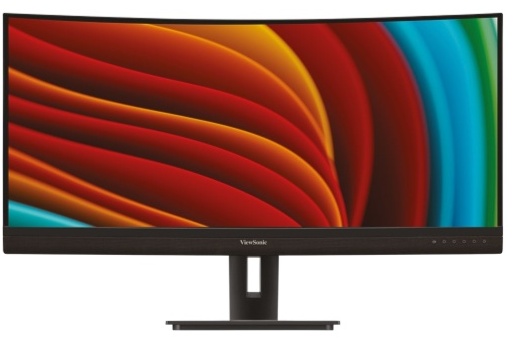Why you can trust TechRadar
This review first appeared in issue 357 of PC Pro.
A letter can make a big difference in a monitor name, and none more so than here. The ViewSonic VG3456 is a highly affordable flat-screen monitor that you can now purchase for around £250, while the VG3456C is curved – exactly like the AOC CU34P3CV and Philips 34B1U5600CH. They also share the same 3,440 x 1,440 resolution, giving you huge amounts of space on which to spread your windows, and VA technology.
The ViewSonic is the most stylish of the three, with slim bezels and a fuzzy speaker-like finish to the bottom edge of the monitor. We only wish the pair of 5W speakers could live up to the billing, but like so many others here they’re better suited to speech radio and web calls than listening to music or enjoying films.
We were also struck by this monitor’s tilting skills: you can push it backwards by 40°, which may well be the killer feature for some situations. While its height adjustment is limited to 110mm, that should be enough for most setups, and we’d give it a firm tick for stand quality overall: you feel like you’re buying a high-quality piece of kit.

The panel is much more average. Rather than true 8-bit color, this is a 6-bit + FRC affair, and this is one reason why its gamut is more limited than its curved 34in rivals. In native mode, it covers 74% of the DCI-P3 gamut compared to 88% and 85% for the AOC and Philips. But if you’re happy with the sRGB gamut then it’s fine, covering 97% out of a 104% volume. Accuracy is strong, too, with an average Delta E of 0.69.
With a stated peak brightness of 400cd/m2, we were surprised to find the monitor maxed out at 280cd/m2in our initial tests. But then we went into the (excellent) OSD and discovered that ViewSonic ships it with the Energy Saving mode switched on; deactivating this pushed the panel up to 435cd/m2. This also boosts the whiteness of the whites, but the penalty comes in power consumption: 48W compared to 31W at 200cd/m2.
ViewSonic doesn’t load this monitor with extras, so if you’re hoping for a webcam or KVM switch then you’ll be disappointed (there’s no USB-B input, either). But it does cover the docking station basics, with an Ethernet port and a USB-C video input that can deliver 98W of power. All four USB-A ports are 3.2 Gen 1, so 5Gbits/sec, with two sensibly positioned on the left-hand side.
It adds up to a solid curved 34in monitor, even if we prefer the punchier colors from the AOC and Philips. If the price drops it will become a strong choice.
Tim Danton is editor-in-chief of PC Pro, the UK's biggest selling IT monthly magazine. He specialises in reviews of laptops, desktop PCs and monitors, and is also author of a book called The Computers That Made Britain.
You can contact Tim directly at editor@pcpro.co.uk.
What is a hands on review?
Hands on reviews' are a journalist's first impressions of a piece of kit based on spending some time with it. It may be just a few moments, or a few hours. The important thing is we have been able to play with it ourselves and can give you some sense of what it's like to use, even if it's only an embryonic view. For more information, see TechRadar's Reviews Guarantee.
You must confirm your public display name before commenting
Please logout and then login again, you will then be prompted to enter your display name.

